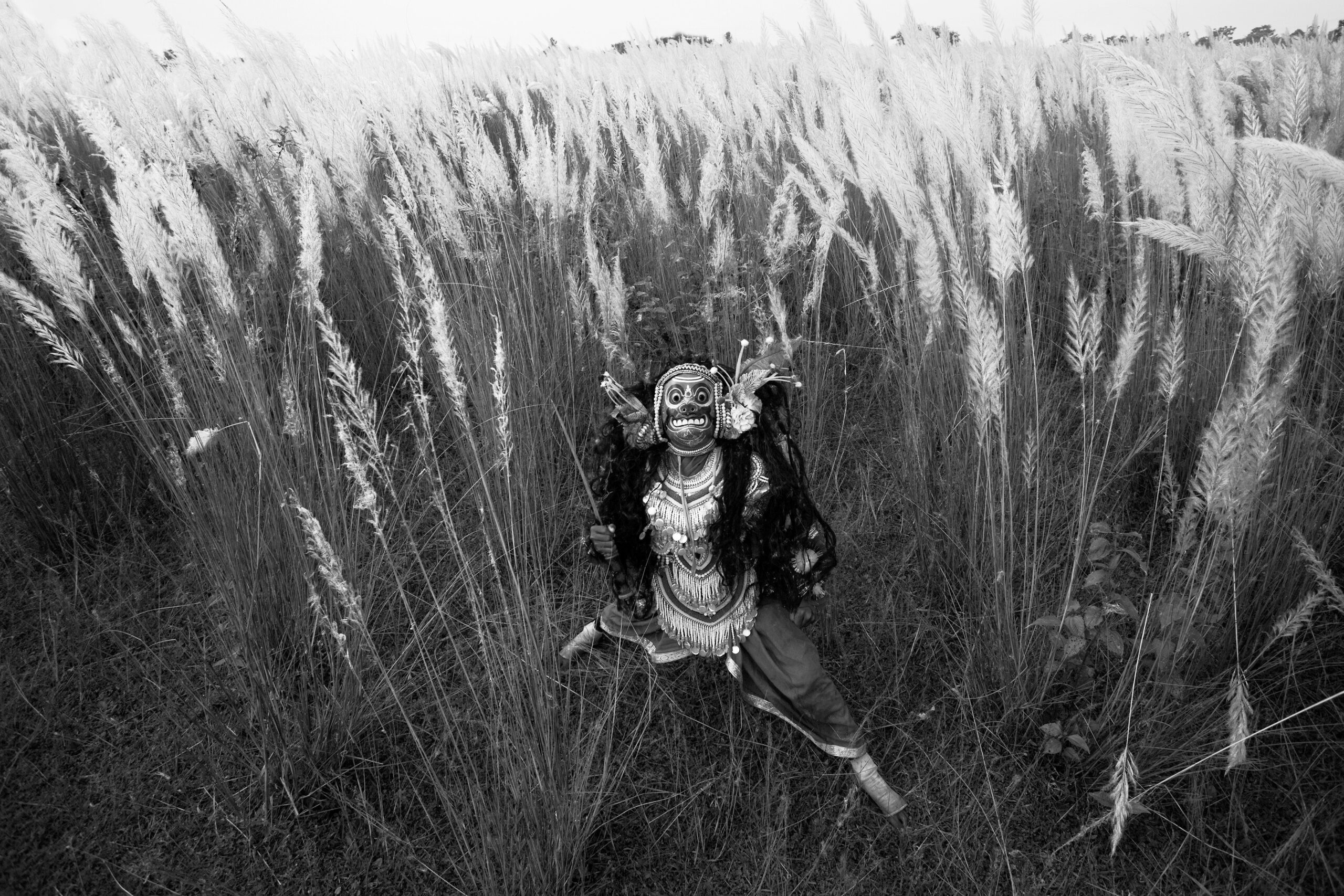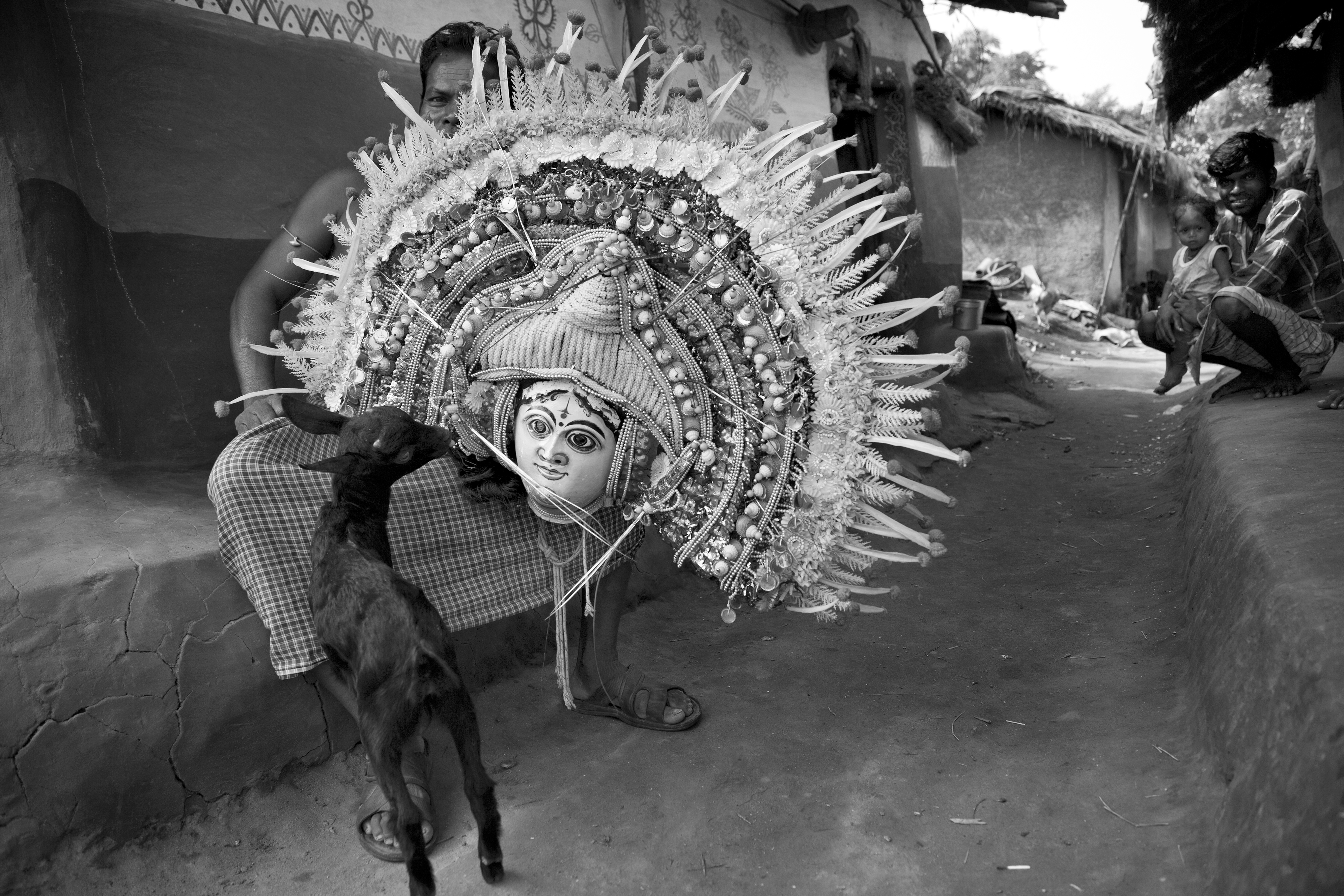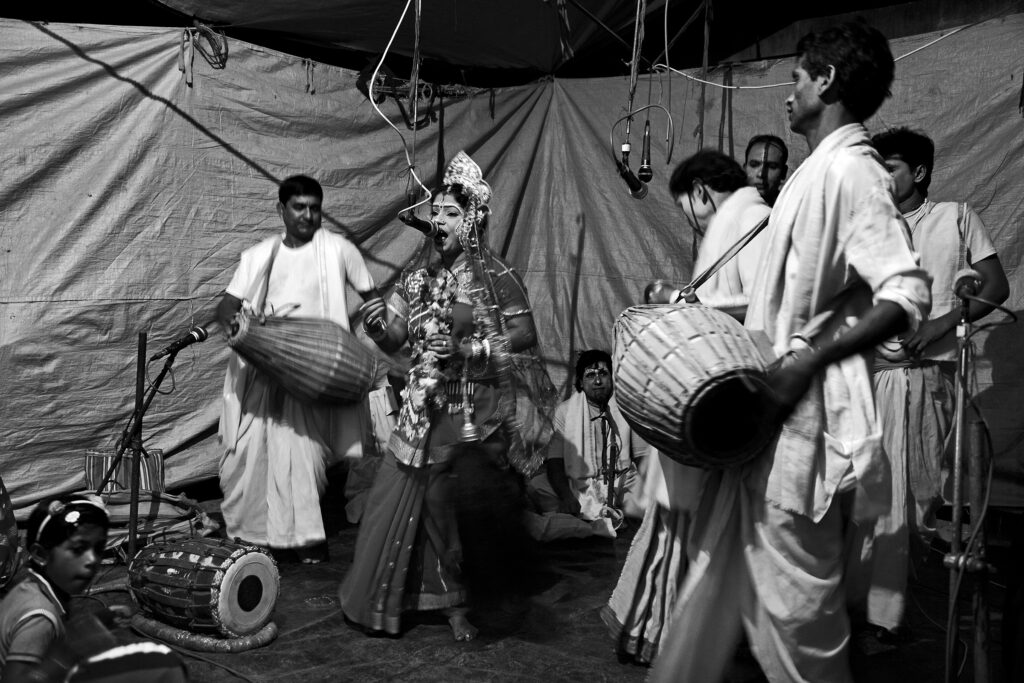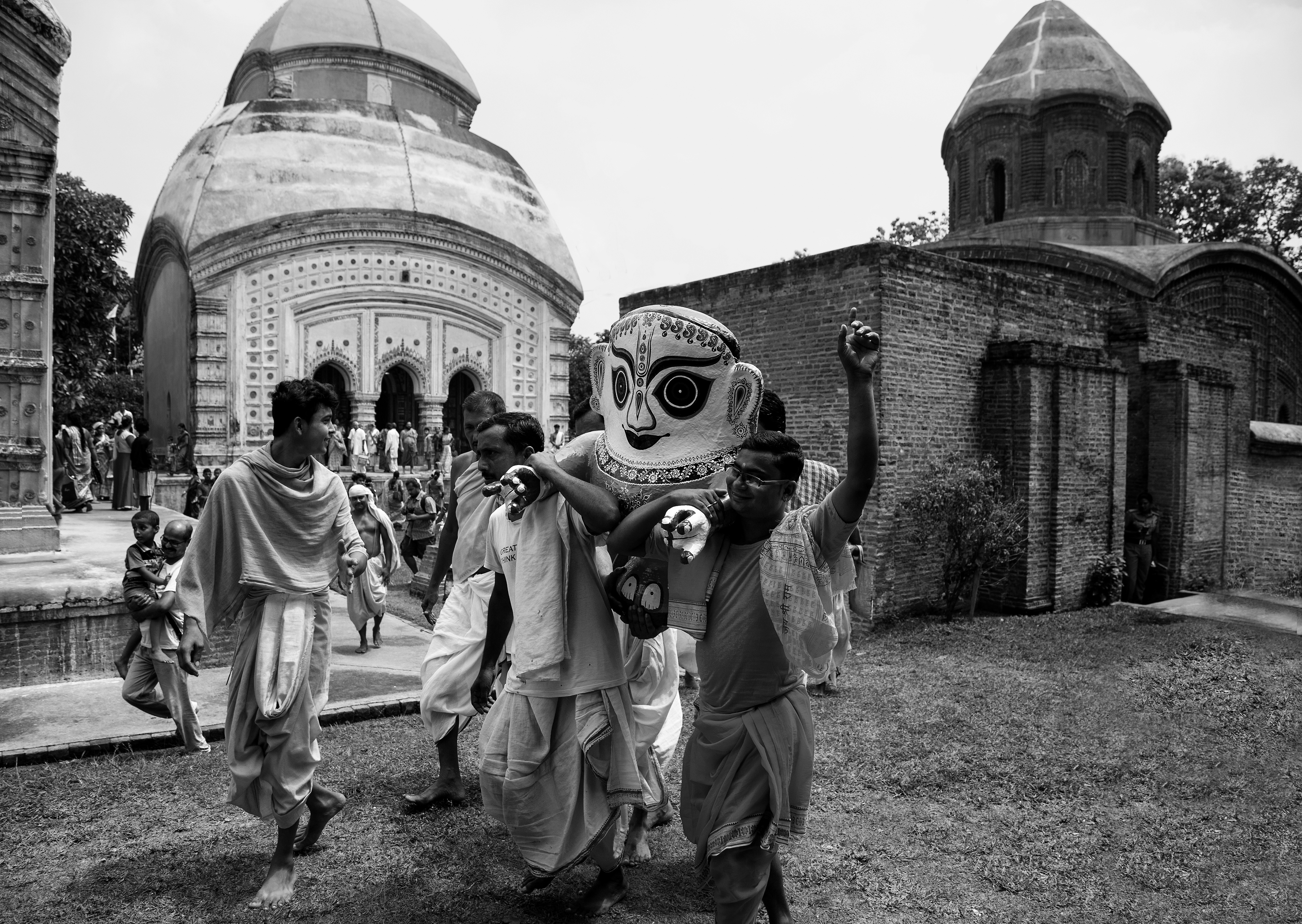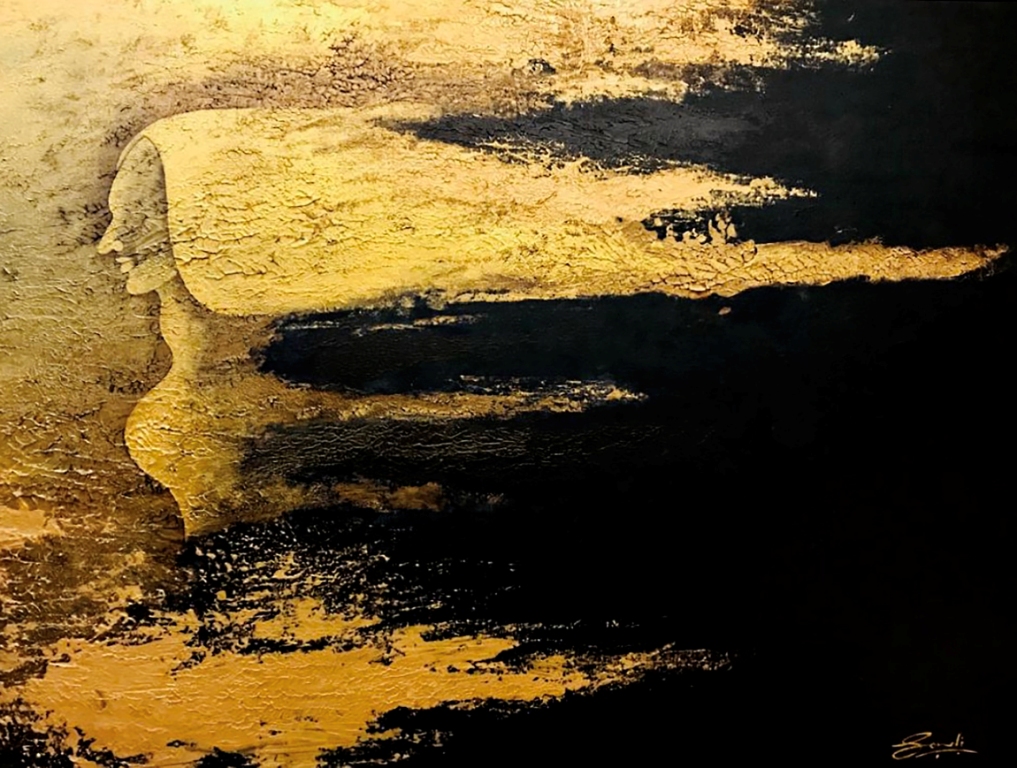At the beginning of the year 2023 the first time I met Sanjay Das in the ambient glow of the art exhibition presented by Art Konsult at the Visual Arts Gallery, I stumbled upon a captivating world through the lens of Sanjay Das. His work titled Jalsaghar spoke in the silent language of visual poetry, capturing moments suspended in time. As I meandered through the frame, his photograph told a unique story, unravelling emotions and narratives frozen in pixels.
In the corner of the room, amidst the soft hum of admiration, our eyes met. Sanjay Das, a master of capturing the ephemeral beauty of life, stood by his creations. His gaze held a quiet confidence, a deep connection with his art. Intrigued, I approached, eager to dive into the mind behind the lens. Sanjay Das, a masterful photographer, stood quietly amidst his creations, his eyes reflecting the passion that infused his work.
We exchanged words that transcended the typical small talk of gallery encounters. His passion for photography flowed seamlessly into our conversation, painting vivid pictures with words. Each anecdote revealed not just technical prowess but an intimate relationship with the subjects and settings he chose to immortalize. The synergy between his artistic vision and the stories he shared created a magnetic pull, drawing me into the universe he crafted through the viewfinder.
As we delved into the intricacies of his creative process, I found myself enamoured not only by the photograph but by the artist himself. There was a genuine authenticity in his expression, a sincerity that mirrored the art hanging on the walls around us. In that shared space of art appreciation, a connection blossomed—fueled by a mutual understanding of the profound impact images can have on the soul. I believe his lens seemed to possess a magical ability to distil moments into timeless visual poetry.
In between we met Several times in the office of Art&Deal Magazine and my curated show, Trovaille, in September, and had lots of random discussions on Art and its changing scenario.
By the end of November 2023, I visited his solo exhibition “The Red Hibiscus Trail,” in New Delhi, which was presented by Gallery Ragini and curated by Ina Puri and displayed at LTC Gallery, Bikaner House, New Delhi. “The Red Hibiscus Trail,” masterfully delves into the rich tapestry of the rural landscape of Bengal’s cultural identity, presenting a visual feast that explores the city’s vibrant heritage, mesmerizing performances, and sacred ceremonies. Through a lens that skillfully captures nuanced moments, the exhibition offers a compelling narrative of Bengal’s soul, inviting viewers to immerse themselves in the multifaceted beauty that defines this cultural haven.
The exhibition opens a portal into Bengal’s diverse cultural landscape, showcasing the rural Bengal’s dynamic fusion of tradition and modernity. The photographs beautifully capture the kaleidoscope of colours during festivals like Durga Puja, highlighting the intricate artistry of pandals and the fervour of processions. Each frame tells a story of community, tradition, and resilience, encapsulating the spirit of Bengal’s people in the face of cultural evolution.
The lens seamlessly transitions to the beautiful captures of Pateshwari Durga, Bhashan Pukur to Pal Bari Durga, where people or sangha celebrate the divine forms of goddesses. The play of light and shadow in these images adds depth, emphasizing the dedication and craftsmanship embedded in Bengal’s cultural practices. It’s a celebration of identity, where the old and new coexist, forming a harmonious continuum.
The exhibition unfolds a captivating visual narrative of Bengal’s performing arts scene, where the landscape comes alive with the rhythm of music, the grace of dance, and the expressions of theatre. From the lively beats of Chhau, Nachni dancer’s “Jhumur” on the streets to the refined elegance of Mansa Mangal Pala, The main character of the ancient Bengali narrative poem Mangal Pala is Mansa, a fertility goddess and serpent who sprung from the vibrant folk traditions of Bengal. The poetry is brought to life by “pala,” which are traditional songs from the area that are weaved together with music and drama, the frames encapsulate the energy and passion that define Bengal’s performance culture.
The juxtaposition of the Nachni dancer which is inspired by the baiji culture of the 18th century against the backdrop of the Mansa Mangal pala, a folk narrative creates a dialogue between the past and present, emphasizing Bengal’s ability to reinvent itself while staying true to its roots. The photographs capture the ephemeral beauty of street plays, where raw emotions blend with urban landscapes, forming a unique and powerful commentary on societal issues.
The lens then shifts to Bengal’s architectural treasures, each photograph a testament to the city’s colonial history and the resilience of its heritage. Iconic structures like the Victoria Memorial, Lalji temple, Chetla Rasbari, Fauti Masjid, Tamluk Rajbari, and terracotta temples and sculpture of Varaha are immortalized in their timeless splendour, serving as anchors that connect the present with Bengal’s storied past.
The exhibition skillfully navigates the narrow lanes of North Kolkata, unveiling ancestral homes adorned with intricate ironwork and colonial facades. Each frame invites contemplation on the preservation of architectural legacy in a rapidly evolving cityscape. The juxtaposition of historical structures with contemporary life showcases Kolkata’s ability to embrace its heritage while embracing progress.
The final segment of the exhibition transports viewers into the heart of Bengal’s sacred ceremonies, where spirituality intertwines with everyday life. From the dawn rituals on the banks of the River to the grandeur of Rath Yatra, the photographs capture the Bengal’s profound connection to its rituals and the divine.
The play of light in these images adds a mystical aura, emphasizing the transcendent nature of these ceremonies. The exhibition pays homage to the syncretic spirit of Kolkata, where diverse religious practices coalesce, creating a spiritual mosaic that defines the city’s cultural ethos. I posed several questions to him during the “The Red Hibiscus Trail” exhibition.
Recently on 10th March 2024, the “The Red Hibiscus Trail” exhibition concluded at The Ambassador, New Delhi as it travelled to the Taj Ambassador from LTC gallery Bikaner House, New Delhi on 3rd December 2023, so here are several questions to him which I posed during the “The Red Hibiscus Trail” exhibition.
Gaurav Kumar (GK): What drew you to focus on capturing Bengal’s culture and heritage through your lens?
Sanjay Das (SD): India’s rich cultural diversity and its many unique customs and traditions have been a major source of inspiration for me as a photographer and it has always been my endeavour to bring forth the untold stories that this country has to offer, showcasing them to the world at large. The objective is to create imagery that tells a story – in colour, texture, light, and shadow and form a unique blend, which is spiritually as well as mentally rewarding.
A love for Bengali culture and traditions was part of my growing-up years in Delhi. There were those acquaintances with the folklore of Bengal which came my way through legends and stories narrated to me, by the elders in the home. The fervour of Durga Puja, Idol making, Alpona, Jatra (theatre) rehearsals at home, meticulously performed rituals, and the music and poetry of Rabindranath Tagore, all formed a part of my growing-up years. Thus the constant seeping of cultural snippets was made a constant trickle all through childhood in a subconscious permeation process. As a ‘Prabashi’ Bengali. I grew up in Delhi, but the roots were always in Bengal.
GK: How do you approach the challenge of representing the essence of Bengal’s rich cultural diversity in your photographs?
SD:It was indeed a challenge as West Bengal is perhaps the wealthiest state in India with regards to its diverse culture, from its magnificent literature to the colourful and splendid festivals, the state is home to various interwoven traditions, existing in perfect harmony with one another. Also, the landscape is so diverse and varied just like its cultural heritage. From the mountains in the North to the Delta region of the Bay of Bengal in the south, Bengal is like a mini India as far as the topography of the land. The diverse architecture of the land is a homogenous mix of elements from various cultures, including British, French, Dutch, Terracotta, and Islam. Bengal has to its credit several historical monuments that reflect the rich heritage and tradition of the country at large. Till now people outside Bengal were only aware of Kolkata and maybe Santiniketan as being Bengal. I as a photographer was aware that I had to bring to light these unknown aspects of Bengal and stories of a major part of Bengal still unknown to many through my research and visual archiving.
GK: Can you share a specific experience or moment during your photography journey that profoundly influenced your perspective on Bengal’s heritage?
SD: This was when I started travelling to Bengal almost 12 years ago, capturing the essence of rural Bengal. I was shooting in the district of Murshidabad going around taking pictures of places, people, food, culture, and architecture. Around sunset, I took a tea break to talk to the locals. There I happened to interact with an old man popularly known as ‘Chote Nawab’. Our conversation went on for hours over several black teas also known as ‘lal chaa’. His narrations about the land, values, traditions, and culture which are gradually fading away from us deeply impacted my perspective and mission as a photographer. I decided to focus on capturing Bengal, preserving and sharing the stories that might otherwise be forgotten.
As I continue my journey, my work not only becomes a visual documentation but also a bridge between the past and the present, allowing others to appreciate and understand the beauty and significance of the rural Bengal that I experienced. It’s a meaningful way to contribute to cultural preservation and storytelling through the art of photography.
GK: What role does storytelling play in your photography, particularly when conveying the cultural narratives of Bengal?
SD: While completing my qualification from the College of Art, New Delhi, photography developed as a passion in my early college days, and ever since it has spanned more than three decades. In a rapidly changing world, photography is my tool to ensure that the legacy of India’s cultural heritage endures. During my research of 12 years of documenting Bengal, as always I wanted to keep alive through visual archiving the interesting stories of the land for posterity. The remains of a very glorious past and components of our plush ethnicity, that as much as we hope not, may cease to exist in the years to come. That is when these archives may help ameliorate the memories of those generations who may never get to see these lost stories again and aid in presenting images for the generations to come who may never experience them in person.
GK: Are there specific rituals, festivals, or traditions in Bengal that you find particularly inspiring to capture, and why?
SD: The Exhibition brings forth a visual documentation of rural Chhau dance in Purulia, where there is no stage and dancers perform this ancient art form with acrobatic martial moves on flat ground, surrounded by the audience. Accompanied by powerful beats, dancers wear heavy colourful head masks and vibrant attire performing various Pala (acts) embodying the rich ritualistic heritage of Bengal.
Two video installations were also a part of the show highlighting the unknown rituals of Bengal. “Manasa Mangal”, is based on an ancient Bengali narrative poem, and centres on Manasa, the serpent and fertility goddess. Believed to date back to the 13th-15th centuries, it carries cultural weight in West Bengal, India. The poem comes alive through “Pala,” folk songs interwoven with music and theatre, an integral part of the region’s traditions. Held during the monsoon, these performances align with Manasa’s role in protecting against snakebites, prevalent during the rainy season. Despite modern challenges, these events maintain community bonds, ensuring the enduring significance of the poem’s cultural heritage.
The rare performance of the “Nachni” is a remnant of the once-respected 18th-century baiji culture. A unique class of dancers, they maintain a beat through rhythmic foot tapping, keeping the traditional name of their music “Jhumur” (bells worn on the ankles). Nachni has a deep-rooted history in the region’s folk culture. Having undergone significant changes in their social status and role, they continue to contribute to the cultural heritage of Purulia with their traditional music and dance performances.
These rituals and performances are extremely rare and are slowly fading out from Bengals’ traditions and culture. In the hustle and bustle of modern life, it’s easy to overlook the gems of our culture. Photography lets me reveal the hidden treasures, making sure they are remembered for generations to come.
GK: Do you collaborate with local communities, artists, or cultural experts when working on projects related to Bengal’s heritage, and how does this collaboration influence your creative process?
SD: The exhibition entrance had a Tusu, done by local Tribal village artists and it also incorporated my images of the Festival. The Tusu Festival in Purulia, West Bengal, celebrates the harvest with month-long vibrant rituals ending on Makar Sankranti. Tusu Parob (festival) revolves around tribal devotional songs sung by women folk. Locals dress themselves in traditional attire, creating a lively spectacle with vibrant wooden structures adorned with colourful paper origami flowers, honouring both tradition and triumph. The festivities end with the immersion of these Tusu structures in their respective local water bodies.
Durga I, collaborative work with Parimal, a mask artist, was an interesting mix of the mask maker’s skill and my photographic image of a rural Durga idol.
The Collaborative work with Shikha Chattopadhyay, a Kantha artist, had the kantha work as done in the villages traditionally on my image of a terracotta temple plate. Kantha, originating from the word “kontha” for rags, is a traditional craft meticulously carried within the households of rural Bengal. Through free-hand designs and simple running stitches, they repurpose soft, worn clothing, often using threads from old saree borders to craft quilts. In a quaint Birbhum village, three generations of women contribute to this art form. The patterns, rich in symbolism, reflect the maker’s affection for loved ones and are believed to offer protection from the evil eye to the wearer or user. This enduring tradition weaves together beliefs, stories, and generations.
Matsaya Vedh, Collaborative work with Gautam Karmakar, a Dokra artist, had the fish made in Dokra and installed with the image of Arjuna’s Matsaya Vedh forming the facade of a terracotta temple in Bengal.
Patachitra, collaborative work with Bahadur Chitrakar, Patachitra artist, Acrylic and archival print on canvas depicted the story of the Charakha festival in Dhakhin Dinajpur. The storytelling springs to life as devotees search for the sacred Charak Tree in a local pond, and later worship it at the festival site. In a unique tradition, a young man hangs from the tree with hooks piercing his skin, imparting blessings to the faithful. These captivating images, infused with traditional Patachitra motifs like the Trishul and Dhatura flowers, beautifully convey the devotion to Lord Shiva within this Patachitra scroll.
Through my lens, I aim to tell the stories of Bengal’s diverse folk art traditions, capturing the essence of a bygone era that still lives within our communities. Bengal’s folk tradition keeps its culture alive and blending it with my images only seemed natural as all my inspiration and ethos revolves around it.
GK: How do you utilize specific visual elements, such as colour, composition, and lighting, to evoke the emotions and sentiments associated with Bengal’s culture in your photographs?
SD: Most of my images of this series of The Hibiscus Trail have been shot in black and white. Since my objective was to capture the beauty of rural Bengal and the Bengal of the bygone years, black and white images created nostalgia and added drama to the image. Black & white images are minimal and simple, like the journey of the land I was depicting, and helped me to portray the timelessness of the place.
GK: Are there particular photographers, artists, or historical influences that have shaped your approach to capturing Bengal’s culture and heritage?
SD: It’s fascinating how one’s upbringing and cultural environment can play a significant role in shaping their understanding and connection to a place, even if they haven’t physically visited it. My experience of being born and raised in Delhi, despite not visiting Bengal until the age of 42, highlights the profound impact that family upbringing, cultural environment, ethos, and values can have on shaping my understanding of the place.
GK: What advice do you have for aspiring photographers who aim to authentically represent and celebrate the cultural and heritage essence of a specific region through their work?
SD: One’s emphasis on understanding a place and conducting deep research before picking up the camera is crucial for meaningful and impactful photography.
Deep research allows you to understand the cultural nuances, traditions, and values of the place you are capturing. This knowledge is crucial for approaching your subjects with respect and sensitivity, ensuring that your photography is culturally informed.
Taking the time to understand the community and its people fosters trust. Building relationships with your subjects allows you to capture more authentic and intimate moments. People are more likely to open up to a photographer who shows genuine interest and respect for their culture.
Understanding the environmental conditions, lighting, and unique challenges of the location helps you prepare technically for the shoot. This can significantly impact the quality of your photographs.
In-depth knowledge allows you to add layers of meaning to your images. Viewers can appreciate not just the visual beauty but also the cultural, historical, or social significance embedded in your photographs.
GK: Have you ventured into experimental photography, pushing the boundaries of traditional techniques and styles to explore new dimensions of visual expression? If so, could you share an example of a project where you embraced experimentation and the impact it had on your artistic perspective?
SD: I am always open to new ventures in experimental photography. I try to work in different mediums to achieve a new dimension to my artwork. In my ongoing exhibition “The Red Hibiscus Trail”, I have worked with various craftsmen from Bengal. Collaborating with craftsmen and integrating traditional crafts like Dokra, Kantha weaving, and Pattachitra into my photography adds a unique and multidimensional aspect to my artwork. By merging photography with traditional crafts, I have tried to create a fusion of contemporary and age-old artistic expressions. This has given a new perspective on seeing photography and celebrates the rich cultural heritage of Bengal.
The addition of three-dimensional elements, such as the Dokra fish on a photograph of a terracotta wall, adds layers to my storytelling. It creates a visual narrative that goes beyond a flat image, offering viewers a more immersive experience. It’s a collaborative effort that extends beyond the realm of photography, creating a space where various art forms converge.
Leaving the exhibition that evening, my heart echoed with the resonance of his visual symphony. The photographs lingered in my mind, not just as images captured on film but as windows into the soul of an artist. As I walked away, I couldn’t shake the feeling that our meeting had become a snapshot in the gallery of my memories.
In conclusion, I would like to say that the photography of Sanjay Das is a visual odyssey that goes beyond the superficial, offering a nuanced exploration of Bengal’s culture, performance, heritage, and ceremony. As he spoke of his artistic journey, I sensed the profound connection he had with his subjects – be it the play of light on a weathered facade or the unspoken stories etched on faces weathered by time. Sanjay’s words painted vivid images in my mind, making me feel like a silent observer in the scenes he so skillfully captured. Through the lens of Sanjay, the ruler’s essence of Bengal is distilled into images that resonate with authenticity and emotion. This exhibition is not just a collection of photographs; it’s a profound meditation on Bengal’s identity—a city that embraces its past celebrates its present, and envisions a vibrant future. Each frame is a brushstroke, contributing to the masterpiece that is Bengal, captured in its full splendour.
About Sanjay Das
Read More>> Please Subscribe our Physical MagazineSanjay Das (born in 1969), a “prabashi”, grew up in Delhi and recalls his childhood in the Krishnanagar neighbourhood, where the combined family resided in a three-story house with one level exclusively devoted to “puja rituals and worship.” Sanjay remembers those years fondly, as do his visits to his maternal uncle’s home in Motihari, where “Jatra” performances were a frequent occurrence because they were founding members of Sreemoti Opera, one of the city’s first folk theatre groups.
In retrospect, the photographer recognizes these cultural experiences as defining moments that shaped his aesthetic consciousness and a Bengali identity that was transient. This sense of belonging got stronger at Raisina School, where he attended 11th and 12th grades. By the time he enrolled at the College of Art, New Delhi, he was certain that he knew the path he would choose in his artistic endeavours. Unbeknownst to him, his art professor, Manab Banerjee, had already sparked his curiosity by taking his class on study visits to the city’s heritage structures and archaeological sites of Delhi. In a way, these training sessions piqued his interest when he began his travels, and he hoped for the day he would learn more about Bengal, along with his endeavour to portray the spirit & the soul of India. Sanjay Das has worked as a freelance photographer for over a decade, with numerous Solo exhibitions and Group shows to his credit.
His portfolio told tales of diverse landscapes, human resilience, and the nuanced interplay of shadows and highlights. Each photograph is a testament to his keen eye and unwavering dedication to the art form. He works and resides in Delhi.
